Stories
Sarah Chisnall
1968-
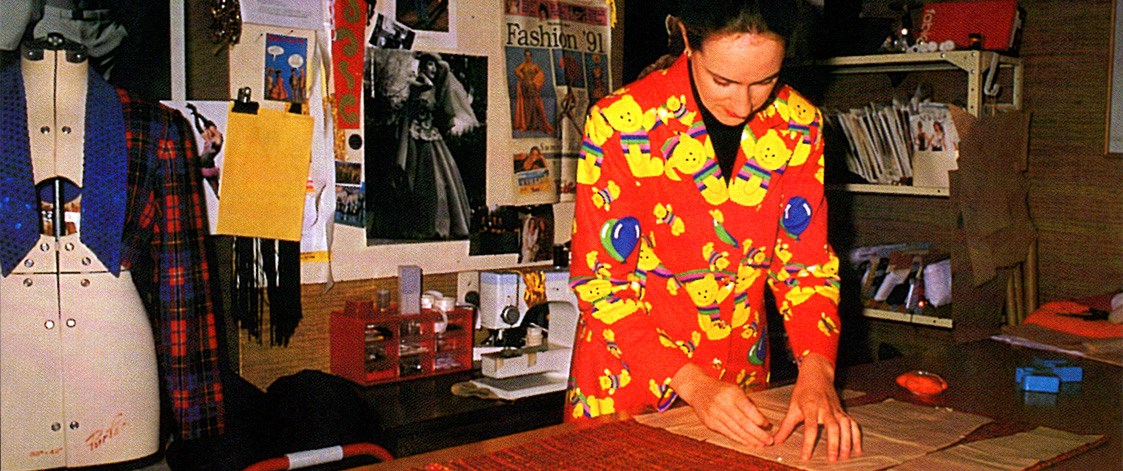
Sarah Chisnall’s journey from home sewer to fashion designer exemplifies the career trajectory of many young New Zealand designers in the 1980s and 1990s. Sarah became a household name through the Benson & Hedges (later Smokefree) Fashion Design Awards which she entered every year from 1988 to the awards demise in 1998. During this time she received 24 nominations, four of which were highly commended and in 1991 she won the prestigious Young Designer Award.
For the self-taught Christchurch designer the Benson & Hedges Fashion Design Awards were an annual highlight. With her Mum, Janet Chisnall, Sarah dedicated at least two months of each year to working on multiple entries. The first time she entered she submitted three garments, one of which was nominated for the After 5 High Fashion Section. The dress, featuring a black velvet bodice and dramatic red moire taffeta puff skirt, reflected Sarah’s love of colour and interest in haute couture.
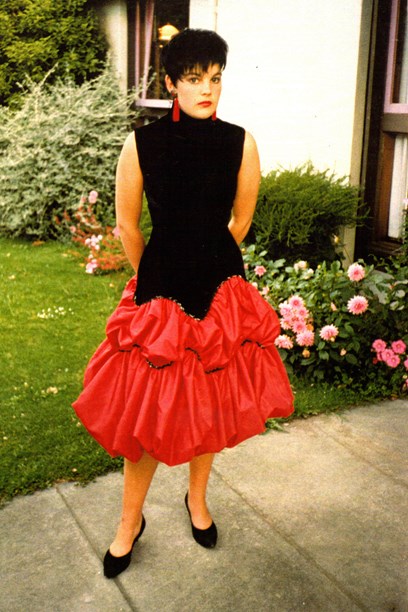
Sarah Chisnall received an After 5 High Fashion nomination for this dress in the 1988 Benson & Hedges Fashion Design Awards. Image © Sarah Chisnall.
Sarah's other entries were selected for the Highlights Parade, a parade held for the live audience before the main televised part of the event. This section provided a showcase for designs not nominated for the awards but which judges felt had potential.
A fun and funky tartan outfit, designed for clubwear, won Sarah the coveted Young Designer Award for emerging new talent.
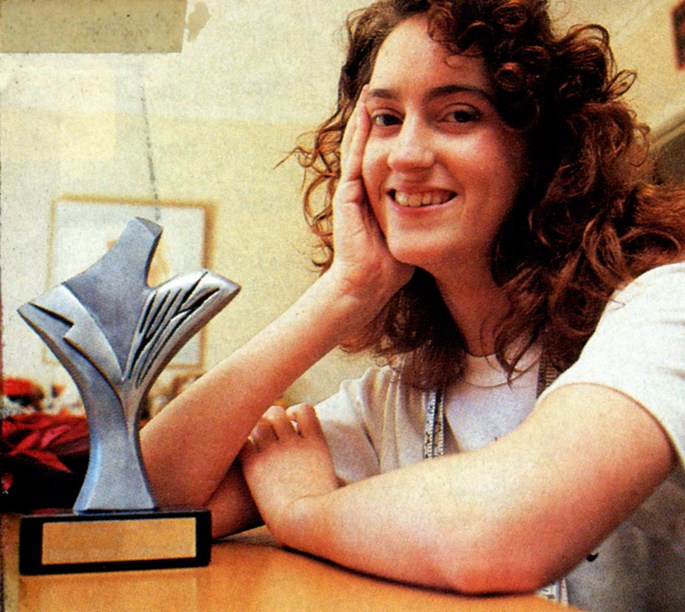
Sarah Chisnall won the Young Designer Award at the 1991 Benson & Hedges Fashion Design Awards. Image © Sarah Chisnall.
Consisting of tartan tap pants, a Lycra top, bolero-style jacket with blue sequined lapels, and a tartan cap made by Di Powell, the ensemble was selected for the exhibition When Dreams Turn to Gold: The Benson & Hedges and Smokefree Fashion Design Awards (Dunedin Public Art Gallery 18 March – 25 June 2017). Made on a home sewing machine, the garment, modelled on overseas trends, was vibrant and contemporary, exemplifying the narrative of – turning dreams into gold - transforming home sewers into aspiring professional designers. As Sarah noted in the exhibition catalogue, the Awards "showed that we could create garments on a home sewing machine, just as well as professionals." Sarah still has the machine, a trusty Elna, and although it has recently been replaced by a newer model Sarah is loath to part company with the equipment that helped her stitch up her designer aspirations.
Highly Commended certificates were awarded in the following sections: Nightlife Collection (1993); Lifestyle Award (1994) for a knitted dress and waistcoat; Menswear Award (1996); and High Fashion Collections (1997). The latter entry consisted of three asymmetric body skimming outfits in chocolate brown lace and striped knits. The diversity of the categories in which Sarah had work nominated demonstrates her resourcefulness as a designer, a skill honed through the various channels used to teach herself to design.
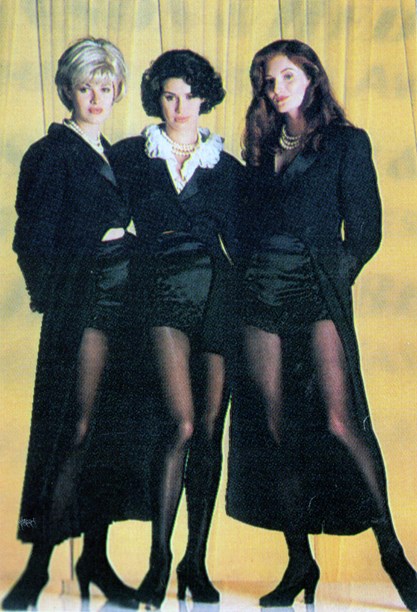
Sarah was highly commended in the Nightlife section of the 1993 Benson & Hedges Fashion Design Awards. Image © Sarah Chisnall.
Janet Chisnall, a trained tailoress, taught her daughter to sew at a young age. At high school Sarah won a number of make and model Zonta Dressmaking Awards. She also sewed for Martin Trusttum, who had a stall at the Arts Centre Market in Christchurch. Inspired by the pirate-themed New Romantic styles coming out of the United Kingdom in the mid-1980s they made pirate shirts, jester trousers and quilted vests.
On leaving school Sarah initially considered a Home Science degree with a view to becoming a sewing teacher but decided instead to pursue a career as a fashion designer. It was the 1980s and an exciting time to be in fashion. Not only did the Benson & Hedges Fashion Design Awards promote fashion as a glamour industry, fashion careers in New Zealand were gaining a higher media profile with the 1980 launch of Fashion (rebranded Fashion Quarterly in 1986) and the more experimental fashion magazine ChaCha (1983-1988). The television drama series Gloss (1987-1990), set in the office of a fictional fashion magazine, also made a career in fashion seem exciting.
At the time Wellington Polytechnic and Auckland Technical Institute were places where you could study fashion design, but this was financially out of reach. Undeterred, Sarah bypassed tertiary study and turned her skills into profit, making garments under her first label Sugoi, the Japanese word for 'cool', or 'wow'. The garments were sold at Savannah, a boutique in central Christchurch. Inspired by pop music videos which gave insight into international trends, the Sugoi label featured bubble and ra-ra skirts, bike shorts and crop tops.
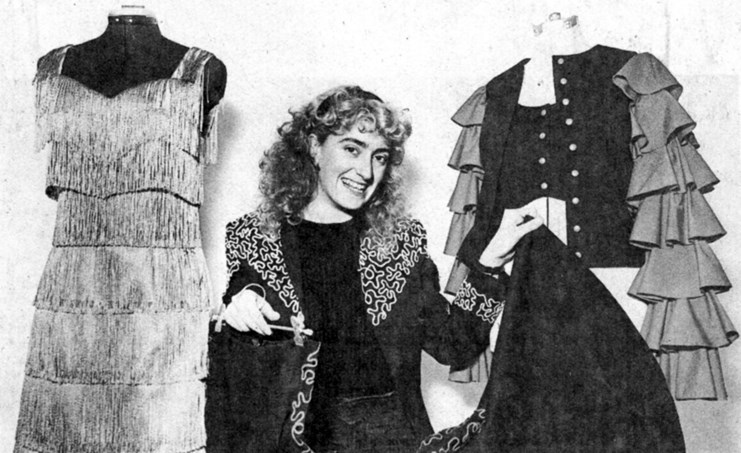
Sarah Chisnall with three of her designs for her label, Sugoi. Image © Sarah Chisnall.
In the late 1980s Sarah bought out Savannah renaming the shop Sugoi Hot Couture, a play on 'haute couture'. She made all the garments with her mother, including special outfits for hairdressers and hairdressing competitions and seminars, and nightclub bands. Although she enjoyed collaborating with hairdressers, photographers and make-up artists Sarah did not make a lot of money and closed her shop after two years. While she loved sewing Sarah acknowledges she had very little experience in the business side of the fashion industry.
Upon closing her boutique Sarah designed and sewed from workrooms, and at home, making directly for clients under her own name, Sarah Chisnall, which by now had a high profile due to exposure generated by the Benson & Hedges/Smokefree Fashion Design Awards.
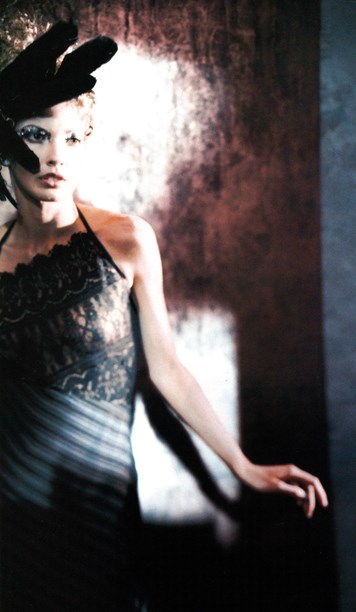
After closing her shop, Sarah designed under her own name. Image © Sarah Chisnall.
Commissions in this chapter of Sarah’s career included evening and special occasion gowns; she made wedding attire for 10 years, including one commission for a guest attending a royal wedding. She also dressed clients for international hair shows in the United Kingdom, and provided garments for former Miss New Zealand, Lana Coc-Kroft, to wear on the New Zealand version of Wheel of Fortune. Lana co-hosted the game show from 1991-1996.
Reflecting on her time as part of the fashion scene in the 1980s and 1990s Sarah acknowledges that the market for fashion in Christchurch was tough and "very conservative". The city’s moneyed dedicated followers of fashion had a penchant for navy coloured-items; whereas Sarah preferred black – a colour sought out by young trendsetters who wanted something different, but often did not have the income to purchase their style preferences. Her boutique was in a central location but not well placed for attracting the foot traffic of her target market.
Nationally there were challenges too. New Zealand designers had to order fabrics from overseas months in advance and wait for international fashion magazines to arrive on our shores; Sarah still has her collection of treasured Collezioni magazines. Music videos provided designers with the fastest access to international trends. The fashion landscape was very competitive; designers had to be resilient and self-reliant in learning new techniques, and finding suppliers. Sarah used Vogue patterns with instructions to develop the skills now taught in fashion schools.
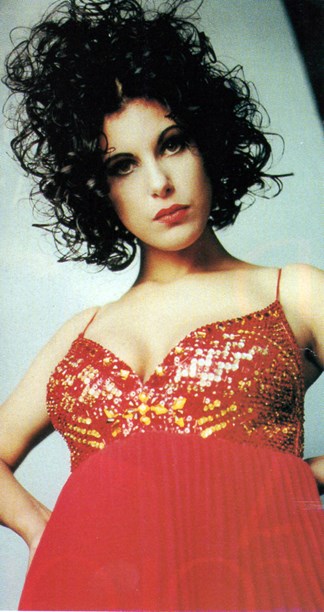
Sarah Chisnall's entry in the Nightlife section of the 1994 Benson & Hedges Fashion Design Awards. Image © Sarah Chisnall.
Sarah has fond memories of her time in the fashion spotlight, Christchurch was, and remains, a strong fashion hub and some of the local designers working at the same time as Sarah are still in business, notably Barbara Lee and Sharon Ng. While, Martin Trusttum, who had also entered the Benson & Hedges, went on to work as a pattern tutor at CPIT (Christchurch Polytech Institute of Technology). After she gave up her last client Sarah worked in a handcraft supply shop, sharing her love of handcrafting and developing new skills. She still has a passion for fashion and is tempted to one day return to the industry.
Text by Natalie Smith. Banner image © Sarah Chisnall.
Last published March 2019.